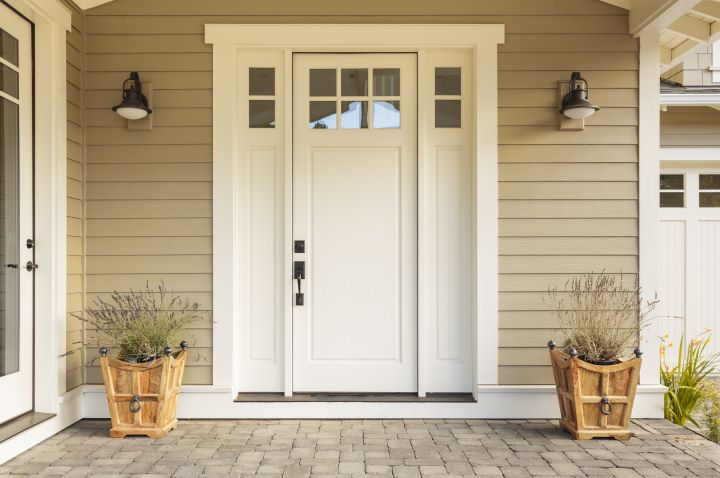With the right coat of paint, the entry door would be the star of a home’s exterior. The entry way is the perfect opportunity to add a pop of color and show off both your exterior design skills and your personality. But how do you choose a front door color that stands out without having to be too over the top?
We’ll help make choosing the color for your front door easier with the guide below. Learn why choosing a paint color for your entry way is important, how to pick the right one and how to choose a paint color for your front door that’s in vogue.
WHY CHOOSING FRONT DOOR PAINT COLOR MATTERS
An entry door is also a guest’s first impression of your house, and it influences that they feel entering your house.
Before learning how to choose a front door color for your house, you may want to know why selecting the right shade is so important anyway. Because the entry door is such a notable feature of a home’s exterior, there are many reasons choosing the best entry way color should be one of your top priorities.
Here are 10 reasons why you need to find out how to choose a paint color for the front door:
It’s one of the first things you observe. Your front door is what welcomes you home every single day – the color should have a positive impact on your mood each time you see it.
It’s one of the first things guests see. An doors is also a guest’s first impression of your residence, and it influences that they feel entering your house.
It influences your curb appeal. The doors has a serious impact on a house’s curb appeal. Picking colors for your front door that complement the others of your home can instantly enhance its exterior design.
It lets you show off your personality. When you select a entrance color, you get to express something about your personality and style.
It’s a simple home improvement project. Changing your entry door’s color can be an inexpensive and easy way to refresh your home’s entire entryway.
It can influence mood. The colour of your doorway can produce certain emotions, depending on hue you select.
It makes your home unique. Your entry door’s color allows you to get a little creative and add a playful touch to your home’s exterior without appearing too gaudy.
It sets the tone for your home. The hue of your entry way will convey something about your home and what guests can be prepared to find inside of it.
It’ll set your home apart or help it blend in. The color you choose for your front door can help it to blend in with the other houses in your neighborhood or make it stand out.
It can help sell your home. If you might sell your house soon, painting its entry door with a welcoming or bold color may make it more appealing to potential buyers.The hue of your front door will convey something about your home and what guests can expect to find inside of it.
Tips for Choosing Front Door Color
If it’s time to update your entry door’s look, check out these top 10 10 techniques for how to decide on a paint color for a front door before making the change.
1. WORK WITH YOUR SURROUNDINGS
If you’re not sure where to start out when choosing a entrance paint color, try looking at your home’s natural environment to draw some inspiration. Natural earth tones can have striking curb appeal while still fitting together with the house’s surroundings.
The natural lighting around your entry way can also help you determine which paint color would look best. If you have a darker porch area, a lighter or bright color will stick out resistant to the darkness. On the other hand, entryways with plenty of light suit a darker color.
2. STICK TO YOUR STYLE
You will also need to take your home’s structure and exterior design into consideration when choosing a front door color. The overall style of your home typically dictates which colors would look best on its doors. For example, a traditional home usually looks best with a classic, dark, rich paint color, whereas a modern home lends itself to a more creative color choice.
Select a front door paint color that complements your home’s other accessories, including the coloring and style of your garage door. To keep your house’s colors from clashing, consider making your entry door a contrasting color that adds overall look to your home. If your house’s exterior is neutral, a bold entry way color might provide the contrasting hues your home’s aesthetic needs.
In general, if the materials surrounding your door are dark, a lighter entry way color is most beneficial and vice versa. However, don’t be afraid to be a little unconventional. Your house is an expression of your personality, so feel free to use your favorite color or signature style if that’s what your heart desires.
3. CHOOSE A FRONT DOOR COLOR OUTDOORS
Your front door color will be on the exterior of your house, so prudent to choose the paint color outdoors. Looking at paint swatches outside will help you to observe how the colors look in settings of natural light. Because interior light can be vastly different from natural lighting, stepping outside to look at colors may greatly affect your concluding decision.
If you want to be extra confident in your color choice, tape some paint samples to your front door and check them during the day. This technique will allow you to see the colors in various lighting conditions. For an even more precise look, you can paint small test patches of the colour on your door.
4. CONSIDER THE CLASSICS
Consider the Classics It’s hard to fail with a neutral entry door color like gray, brown or black. These colors are classic hues that will stand the test of time.
It’s hard to go wrong with a neutral doors color like gray, brown or black. These colors are classic hues that will stand the test of time. Even navy blues and deep shades of red are typical entry way colors.
If you want to go extremely minimalistic, you can stain your entry way rather than painting it. Using a wood stain on your entry door will showcase its natural material or grain pattern if you have a wood door.
5. MAKE IT MONOCHROME
For those with smaller houses, a monochromatic color scheme will be your brand-new closest friend. Painting your home’s front door, window frames, trim and exterior all the same color will visually expand your property to make it appear larger than it really is. A monochromatic color scheme also serves as the perfect neutral backdrop for accessories to stick out against, letting you incorporate splashes of color that highlight architectural details.
6. GET CREATIVE
Although by using a bright color on your front door may appear intimidating, painting your door is a lesser commitment than painting your complete house or a room that shade. There is no harm in experimenting a bit, so go ahead and try out a bold color that speaks to you. From bright hues of lime green, yellow or orange to darker shades of forest green, eggplant or burgundy, color can be considered a fun yet complex way to generate a stylistic statement.
7. USE THE COLOR WHEEL
Even those who never studied art or design are most likely acquainted with a color wheel. It’s a helpful reference that displays the relationship among different colors, organizing them into a circle of primary, secondary and tertiary colors. Consulting the colour wheel can tell you which colors complement each other and which ones clash.
When comparing the color wheel to your home’s exterior colors, first think about whether you want to stick to a monochromatic color scheme. If so, you can make darker and lighter shades within the same color. For a more striking contrast, decide on a door color opposite your house’s main shade on the colour wheel.
8. REMEMBER THE TRIM
Remember the Trim Along with the door itself, your entry way trim is a prospect for a new coat of paint. In general, you should avoid painting your door and trim the same color.
Along with the door itself, your front door trim is a prospect for a brand new coat of paint. In general, you should avoid painting your door and trim the same color. Instead, use the trim as an opportunity to introduce a lovely accent color that pulls together the rest of your house’s exterior.
Although white is a popular and reliable trim color, a contrasting trim color can make your entry way really be noticeable. Rich brown tones can bring some warmth to a cool-colored doors. A dark-colored trim can also keep a light-colored doorway from fading into its surroundings. On the other hand, a lighter-toned trim can add some much-needed brightness to a dark-colored door.
9. DON’T FORGET YOUR SCREEN DOOR
If your front door has a screen door or a storm door, consider painting its frame or investing in a new one in a contrasting hue for a double-dose of color. Especially if you chose a more neutral tone for your entry way, the frame of your screen door can become a chance to include a bit of pizzazz to your home’s exterior. Whether you want to include a pop of bold color or not, remember to pick an accent color for your screen door.
10. PICK THE RIGHT PAINT
Because your door has to face the outdoor elements every day, use the right type of paint to avoid peeling and fading in the future. For example, a steel doors could benefit from a paint with built-in rust protection. Normally, latex exterior paints offer weather-resistant coverage for a variety of conditions.
Regardless of the sort of paint you select, you will need to coat your doors with an exterior primer first. You’ll be able to choose a entrance paint with the finish of your choice, including matte, semi-gloss, glossy and high-gloss finishes. Unless you offer an extremely high-quality front door, a high-gloss finish provides out the blemishes. You might want to opt for a semi-gloss paint, which is more forgiving and will hide your front door’s flaws.




